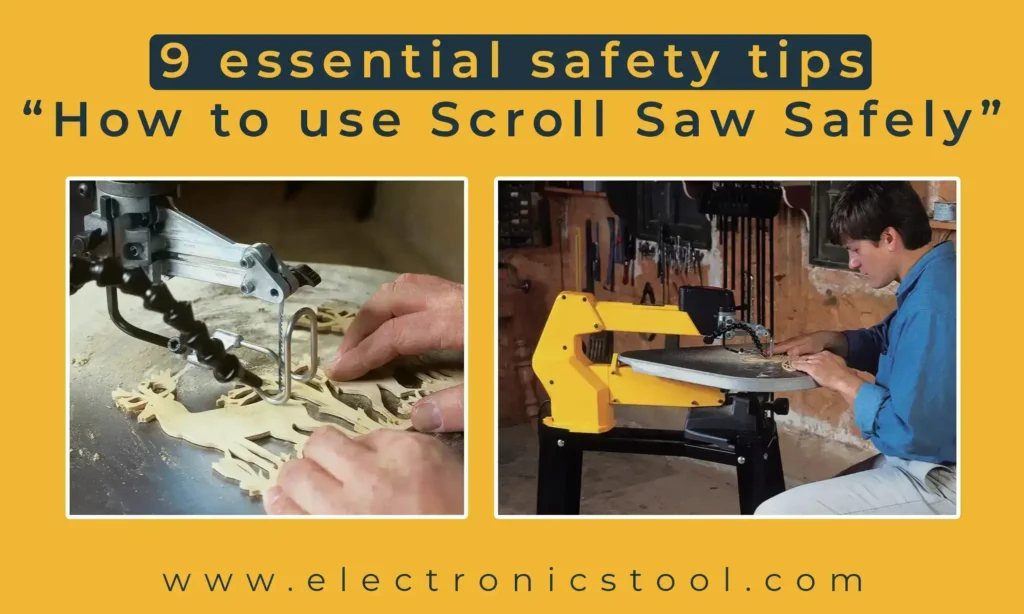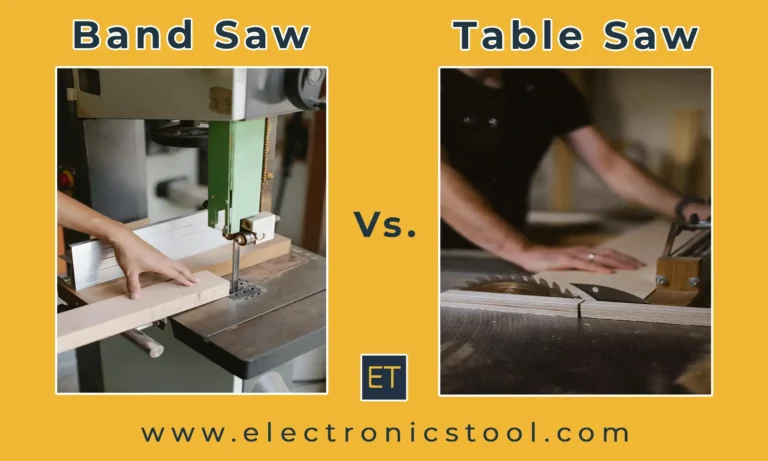Have any beautiful wooden patterns ever left you amazed? Maybe they used a scroll saw to create those. Did it remind you of a bandsaw? Both are familiar, but a scroll saw makes cleaner and more finished cuts.
Crafting with scroll saws is fun, but practicing safety is as important as learning the skill. Fortunately, they are considered safer than table saws and band saws. However, it is stupid to be careless while using any power tool. A study reveals, “Approximately 720,000 injuries occur annually from woodworking equipment, leading to serious health conditions.”
Here, we will share 9 scroll sawing tips for beginners and experts. You will get training for everything, from preparing your machine to successfully processing the cuts. By the end, you’ll know “how to use a scroll saw safely” and bring your ideas to life. Let’s get started!

9 Essential Tips For Using A Scroll Saw Safely
Most of the scroll saw accidents happen because of mindless activity and a lack of self-protection.
Common accidental causes include a shaky or dull blade, forcing the material to cut quickly, and not wearing safety gear. The injuries often lead to fractures and lacerations on the fingers and hands. Therefore, learning ‘how to use a scroll saw safely’ becomes the priority.
1. Understanding your Scroll Saw
Before knowing anything else, it is crucial to understand your scroll saw and how it works. This foundational knowledge sets the stage for all other safety tips and reduces the risk of danger.
Three of its common parts are a thin blade that moves vertically, a motor that powers the blade, and a flat table for placing the material. You may adjust the tension and blade speed based on your potential and project type.
A scroll saw blade moves quickly while making cuts; you guide the material through the blade. For this, you must be very conscious of scroll saw safety. Review the manual for a proper setup and practice with the settings and adjustments for different materials.
2. Preparing your Workspace
A clean workspace that is well-lit and ventilated enhances focus while scroll sawing.
Good lighting is crucial for cutting through the minute details. Your working area should have enough ventilation to avoid breathing in dust. Also, keep your necessary tools and materials within easy reach. This declutters your mind and reduces the risk of accidents.
3. Personal Protective Equipment (PPE)
PPE contains (wearing):
- Eye goggles: for keeping your eyes safe from flying debris or a broken blade.
- Earplugs or earmuffs: for guarding ears against the loud noise of a moving saw.
- A dust mask: to protect the lungs from breathing in polluted air.
- Gloves and footwear: to avoid accidents with sharp blade edges.
Never skip your PPE, even for a quick job. A serious injury can even result from minor errors. Each piece of PPE is crucial for healthy and safe scroll saw cutting.
4. Selecting the Right Blade
The right blade type is the fundamental aspect of using a scroll saw safely. Blades differ from each other in terms of their teeth and specific project types.
We use standard blades for general use; skip-tooth blades cut faster than usual; double-tooth blades give a smoother finish. Also, match the blade to your material and design. Fine blades work well for intricate cuts, while coarse blades are better for thicker materials.
Regular maintenance of blades is vital for clean and safe operation. To prevent injuries, it is mandatory to replace or sharpen the blunt blades whenever necessary Install it tight enough so that it does not kick you back.
5. Proper Material Handling
There are fewer chances of kickback when your workpiece holds a firm grip on the surface. For this, you may use a vice or clamps; they enhance accuracy by preventing unwanted motion.
Use both hands while guiding the material through the blade. Set up the speed according to your ability to handle and the type of material. For instance, work with slower speeds for harder materials (metals) and faster speeds for softer materials like wood.
6. Operating the Scroll Saw
Before starting, ensure the scroll saw is properly set up and the blade is tight and secure. Turn it on and set it to its maximum speed potential.
Keeping a steady grip with both hands, process the material gently through the blade. Avoid rushing the material while making cuts; your finger may slip. It would be best if you placed your hands by the side of the blade and never at the frontline.
7. Maintenance and Inspection
On a well-maintained saw, you work more flawlessly with fewer risk of injuries. Regularly clean the dust and debris from the table and blade area. Lubricate moving parts as recommended in the manual to ensure smooth operation.
Before each use, inspect the saw for any issues. Check the blade’s condition, ensure the motor runs smoothly, and verify that all controls are functional.
“Many accidents happen because of poor maintenance. A loose blade or faulty part can be terrible,” says Emily Larson, a woodworking safety expert. “Regular upkeeping of the scroll saw saves you from unexpected situations.”
8. Advanced Safety Tips
Experienced users have developed an edge on the machine so well that safety has become their nature. But there is always room for improvement. Use these tips to improve the scroll saw’s safety.
- To maintain focus, taking regular breaks during prolonged work is important.
Here’s a real-life example of how David, an experienced user, ignored his fatigue during a long session at the scroll saw. His focus waned, and his hand slipped, causing a deep cut that required stitches. “Listen to your body,” he stressed then. “Breaks help you in focusing better and preventing lethargy during prolonged jobs.” - Plan your work carefully when working on complex projects. Use relief cuts to prevent tight turns and keep the blade perpendicular to the material.
- Adding a magnifying lamp improves visibility while creating minute details.
- Consider double-checking the blade speed and tension before starting.
9. Emergency Preparedness
It is wise to keep a first aid kit in your workspace. Accidents may occur anytime, even if you have a fine experience in scroll sawing.
In case of an injury, stop the saw immediately and reach out to the first aid box. Apply an antiseptic to the wound and wrap it with a bandage. Obtain medical treatment if injured seriously.
Pre-operational Safety Parameters
Operational Safety Parameters
How to close the procedure safely:
- Turn off the scroll saw before removing the plug. So you don’t reconnect it in switch-on mode.
- Reset all guards to their original positions.
- Make sure you leave the saw in a clean state. This prevents the clutter of dust and debris, exceeding its life span.
Additional Resources:
For more information and community support, check out these resources:
Online Forums: Join communities like Lumber Jocks and Scroll Saw Village for tips and advice from fellow woodworkers.
For woodworking tutorials, [woodworkersguildofamerica.com] shares tutorials and safety tips on scroll saws and other power tools. https://www.wwgoa.com/
Conclusion
Safety is a big deal when operating a scroll saw. By understanding your equipment, organizing your workspace, wearing proper PPE, and choosing the right blade, you ensure a safe and enjoyable experience. Regular maintenance and being prepared for emergencies add extra layers of protection. Always practice these safety techniques to keep your projects and yourself in good shape. Knowing “how to use a scroll saw safely” is the key to all of this. We’d love to hear your personal tips or stories—share them with us and help build a healthier woodworking community!
FAQs: Frequently Asked Questions
More Posts You May Like:

7 Best Floor Drill Presses | Complete Buying Guide | ElectronicsTool.com
Spread the loveWorking up on a wood or metal project? Then you must be looking for an easy and best floor drill press to bore holes easily in any sort of wood, metal, or plastic. Floor drill presses are specifically designed to bore holes in any kind of wood, metal, or plastic with no extra […]

10 Best Air Compressors for Automotive Shop | Complete Guide and Reviews | ElectronicsTool.com
Spread the loveAre you expanding your business for automobile repairs or bodywork? Then, an auto shop air compressor is all that you want. It can serve you in a dozen ways, from powering pneumatic tools to sandblasting and more. However, making a smart purchase is hard without proper guidance. The right source of compressed air […]

Band saw vs. table saw | which one should you buy first?
Spread the loveDid you find yourself stuck in the decision loom of band saw vs. table saw? We agree that picking the right machinery for your job is the first step towards healthy woodworking. It is okay if you opt for a more important one in the beginning. You might be a learner or have […]

What a beautiful presentation! I got all what you explained.
Hey people!!!!!
Good mood and good luck to everyone!!!!!
Thank you, the author! You did a damn good job at explaining.
I’ve been using a scroll saw for years, but I never thought about checking for blade tension regularly. That explains a few of my recent issues—thanks for the reminder!
This post is so thorough! I’m curious, do you think wearing goggles is enough, or should I consider a full face shield?
Well, goggles are typically sufficient for most scroll saw work since the blade doesn’t generate a lot of debris. However, if you’re working with brittle materials or in a dust-heavy environment, a full face shield can provide extra protection and keep your face clear of any unexpected injuries.
I made the mistake of not securing my material properly once—it kicked back and ruined the cut. Your tip about clamps is so important!
Great advice! Do you have any recommendations for gloves that won’t compromise grip while using a scroll saw?
That’s a valid concern! Most safety experts actually advise against wearing gloves while using a scroll saw because they can get caught in the blade. Instead, focus on keeping your hands dry and clean for a better grip, and use push sticks or clamps to hold smaller pieces securely.
These tips are a lifesaver—especially for beginners like me. Thanks for sharing!